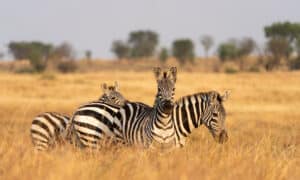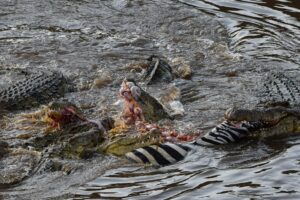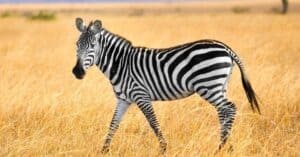Zebras are wild African equines that are best known for their distinctive black and white stripes. There are three species – Grevy’s, plains, and mountain zebras – and they roam in herds. Zebras eat a wide range of different grasses as well as leaves and shrubs. Like horses, they are members of the genus Equus and share a similar number of teeth. However, zebras teeth are highly adapted to their diet. Join us as we discover everything you need to know about zebra teeth!
Zebra Baby Teeth: Milk Teeth
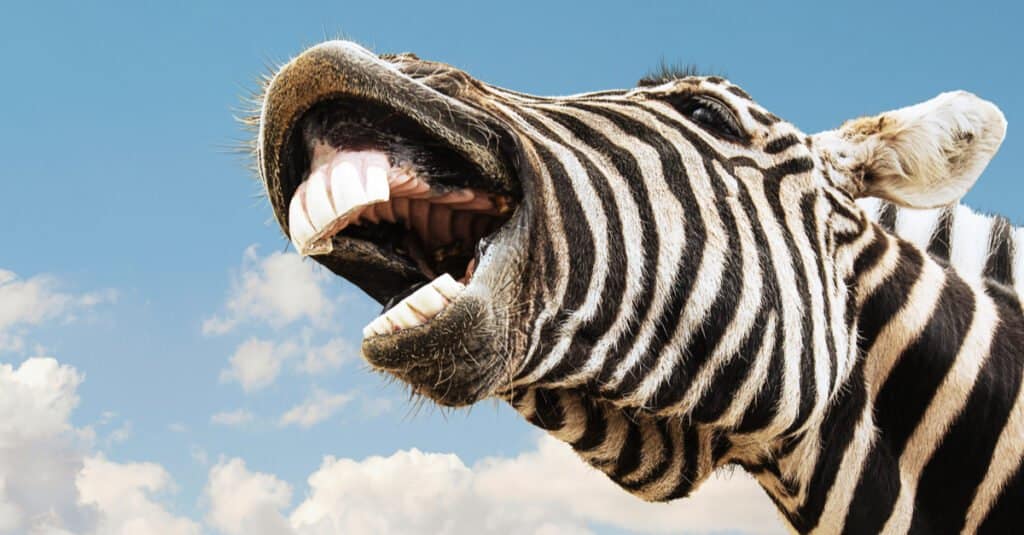
Zebras have powerful incisors that are used to eat grasses and shrubs.
©Mara008/Shutterstock.com
Just like horses, zebras have two sets of teeth during their life, and their first set are known as milk or deciduous teeth. Zebras are born without teeth, but their first tooth usually emerges within one week of birth. They have 24 milk teeth – twelve incisors and twelve premolars. The first teeth to emerge are the central incisors, while the premolars are usually pushing through their gums by the time the zebra foal is two weeks old. The rest of the incisors are usually present by the time they are nine months old.
The adult teeth are situated in the jaw underneath the milk teeth and gradually move up, pushing the milk teeth up with them. When this happens they milk teeth are known as “caps” as they are the cap on top of the adult tooth. Eventually, the adult teeth erupt fully and the caps are shed. All of the milk teeth are usually shed by the time the zebra is five years old. By this time all of their adult teeth are present.
How Many Teeth Does a Zebra Have?
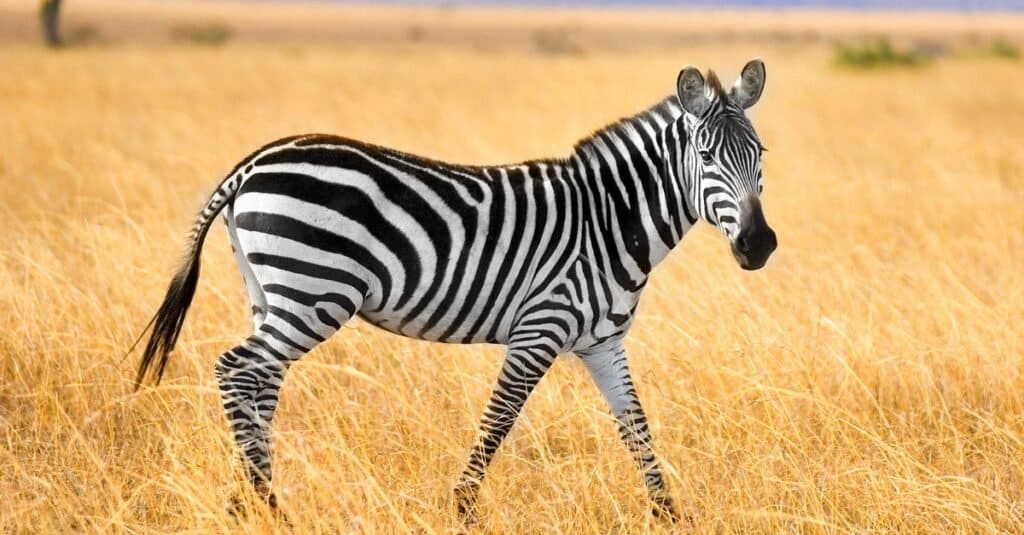
Zebras teeth are adapted to the tough, dry grass that they eat
©iStock.com/GlobalP
Most zebras have a total of 40 adult teeth and these begin to emerge when the zebra is towards two years old.
Zebras are grazing animals and grass makes up more than 90% of their diet. During dry periods they have to forage and dig more for food than usual. Much of the grass that they eat is tough and dry and their teeth are adapted to pulling and chewing it.
Zebras teeth are known as hypsodont teeth. Hypsodont teeth are high-crowned and have enamel that extends past the gum line which allows them to continue to erupt throughout most of the zebras life as the surface is worn down by chewing. Eventually, by the time the zebra reaches old age there is very little crown left as they have been worn away by the constant abrasive motion of chewing.
Incisors
Zebras have twelve incisor teeth – six in their upper jaw and six in their lower jaw. The first pair of adult incisor teeth erupt when the zebra is around 2 years old, pushing the milk teeth out with them. The second pair erupts around a year later, and the third pair a year after that. The upper and lower incisor teeth meet edge to edge and provide and sharp cutting surface. Grass is cropped using the teeth and the movement of the zebras head to pull at the tough stalks.
Canines
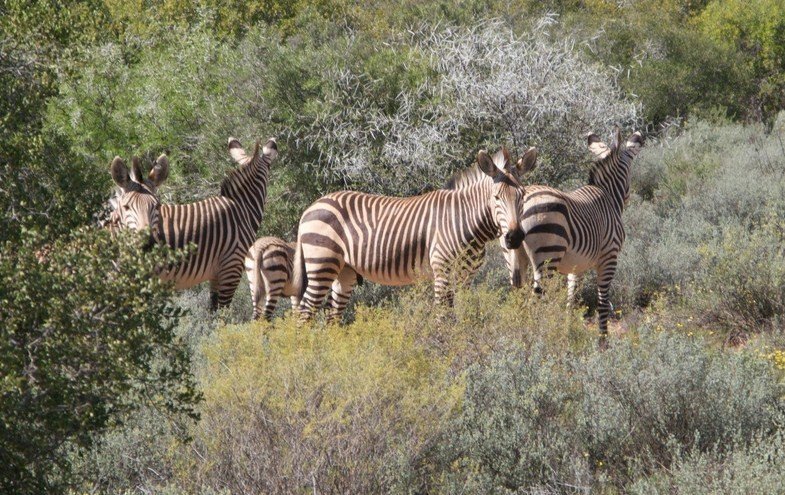
Male zebras use their canine teeth for fighting
Canines are teeth that are best known for their role in carnivorous animals as they are used for biting and killing prey. Canine teeth are redundant in most herbivores, including horses. In fact – just like horses – not every zebra develops canine teeth, but those that do are usually males. Canine teeth in horses are usually small and serve no purpose. They’re not the largest in zebras either, but they do have a role.
When zebras develop canine teeth they usually have four and they are short, sharp teeth that emerge between the ages of 4 and 5. Canines are found in the gap between the incisors and the cheek teeth and the lower canines are positioned in front of the upper ones. The only purpose of canine teeth in zebras is for fighting. Male zebras – particularly those living in bachelor herds – often fight to establish dominance, or pecking order. Male zebras use their canine teeth when nipping and biting each other during a fight.
Premolars & Molars

Zebras can develop small canine teeth.
©Melanie Hoffman/Shutterstock.com
Most zebras have twelve premolars and twelve molars which form part of their cheek teeth. Although they are called molars and premolars they essentially have exactly the same appearance and function. The molars and premolars have a wide, flat surface for chewing and are used for grinding and crushing food. The cheek teeth are covered with a thick layer of cementum as well as enamel which creates a much stronger tooth than one that is covered with solely enamel.
Zebra Wolf Teeth
Just like horses, zebras also sometimes develop wolf teeth. Wolf teeth are very small teeth that have no function whatsoever. They are found in front of the first upper premolar and develop between the age of six and eighteen months. However, not every zebra develops wolf teeth and sometimes they only develop on one side. Wolf teeth in horses usually have to be removed because they interfere with the bit and cause pain, but they don’t cause any issues in zebras.
Grevy’s Zebras Teeth
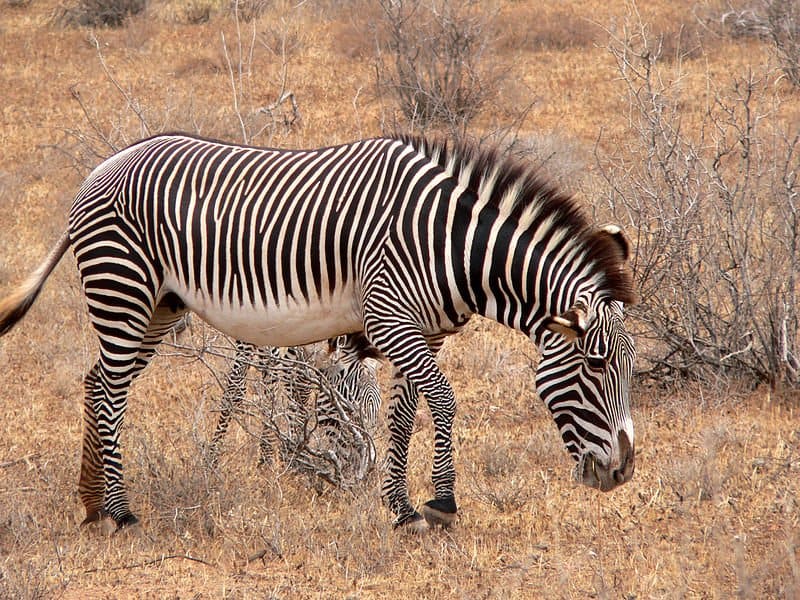
Grevy’s zebras have two extra premolar teeth
Grévy’s zebras are the largest of the three zebra species and live in Kenya and Ethiopia. They are also sadly an endangered species. These zebras are distinguished by their stripes which are much narrower and closer together than those of plains and mountain zebras. They also differ from plains and mountain zebras in a few other ways. They have a different social structure. Instead of living in larger herds, mother and foal relationships are the main bonds, while stallions are extremely territorial. Grévy’s zebras can also survive for up to five days without water. Although they predominantly eat grass, they also eat legumes.
However, the other main difference between Grévy’s zebras and other zebras is the number of teeth that they have. The other two species have 40 teeth while Grévy’s zebras have 42. This difference comes down to the premolars. Plains and mountain zebras both have twelve premolars – three on each side of both their upper and lower jaws. Instead, Grévy’s zebras have an extra premolar on each side of their upper jaw. It is not known for certain why they have these extra cheek teeth, but it is entirely possible that it is an adaptation for their diet. Grévy’s zebras live in particularly harsh, dry conditions and graze semi-arid grasslands. Therefore, two extra cheek teeth are particularly useful for chewing tough grass and legumes.
The photo featured at the top of this post is © Galovtsik Gabor/Shutterstock.com
Thank you for reading! Have some feedback for us? Contact the AZ Animals editorial team.



